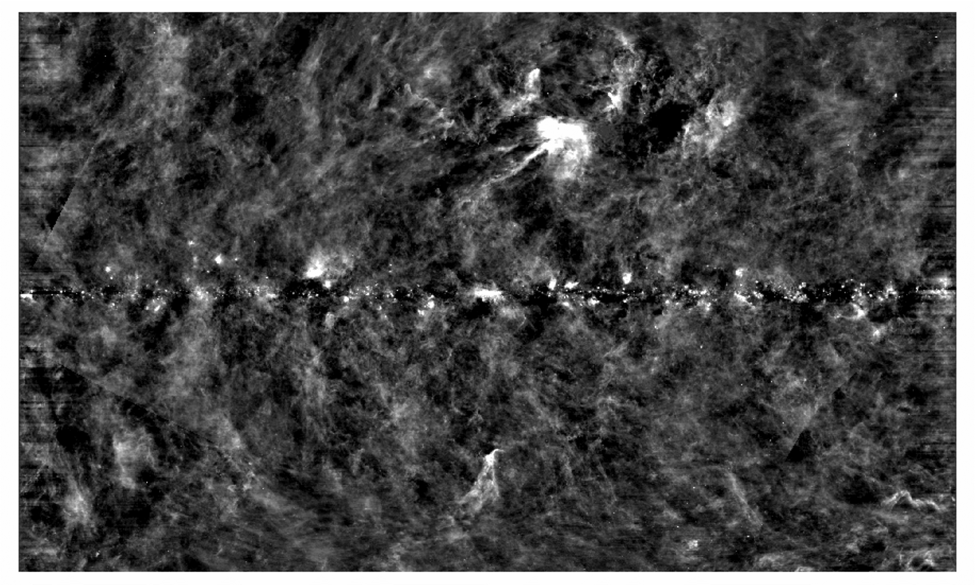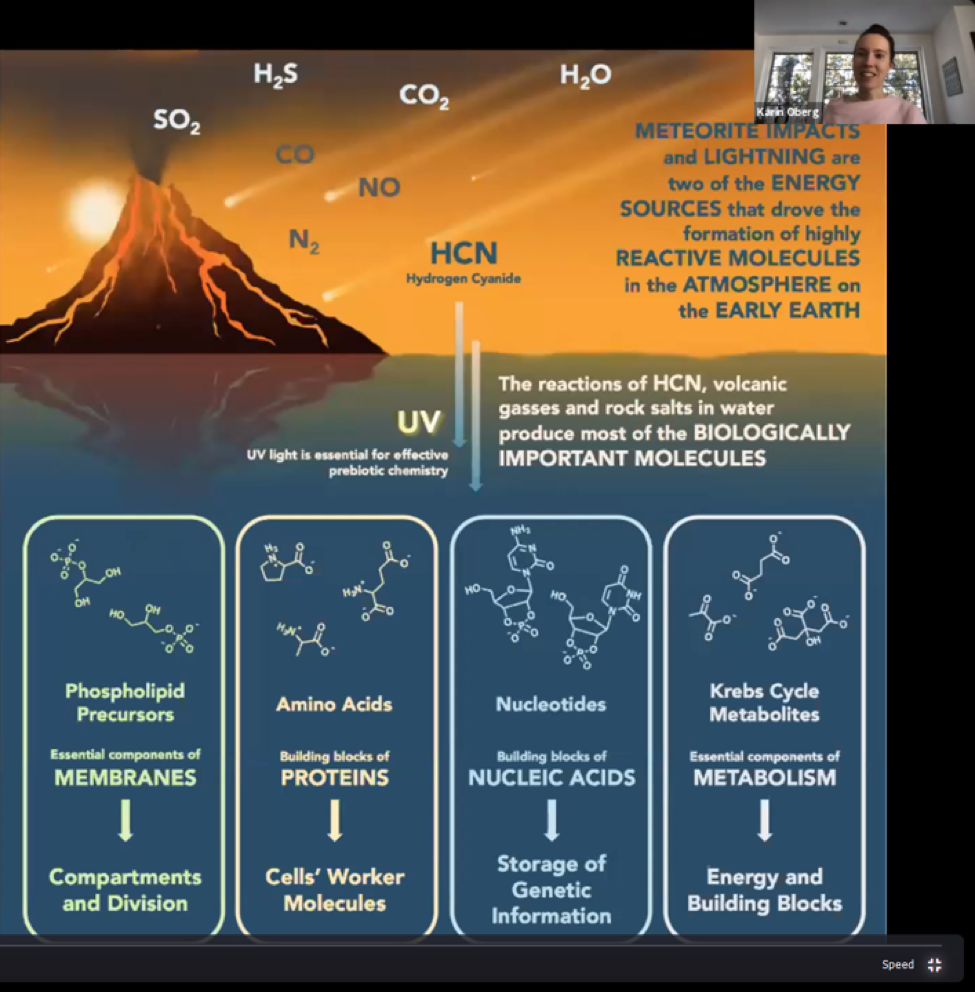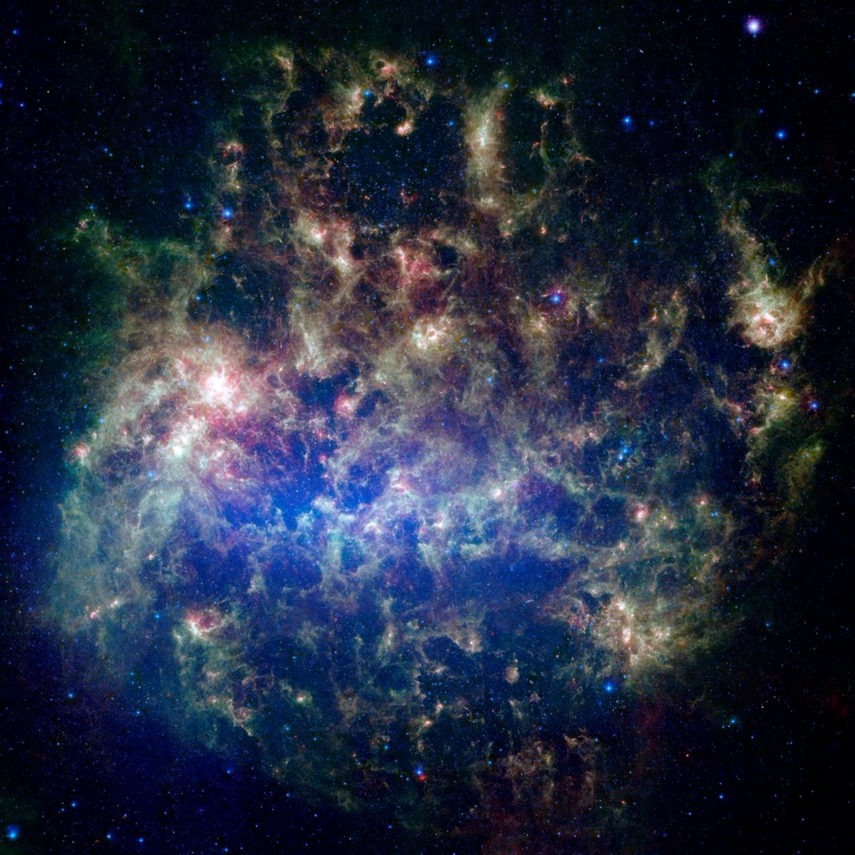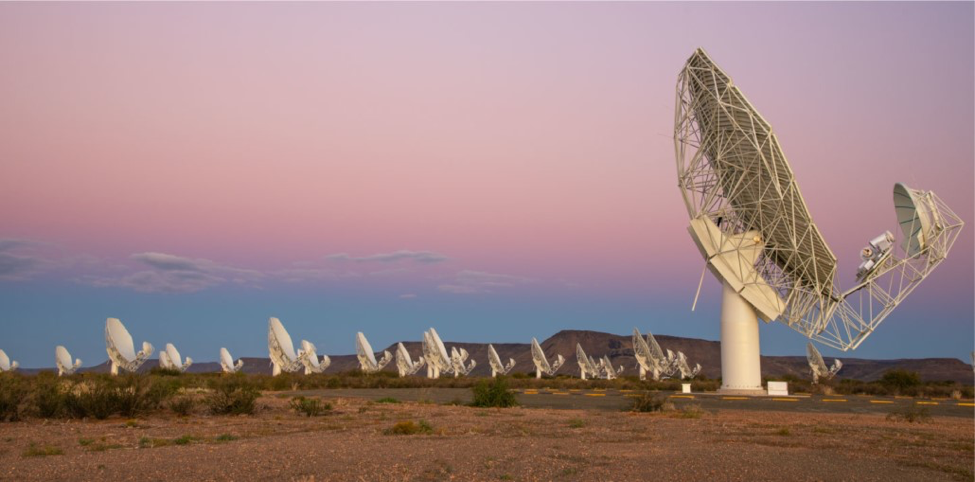William H. Waller – Endicott College and The Galactic Inquirer
Abstract:
Carl Sagan is well-known for having said “The cosmos is within us. We are made of star-stuff.” How that truism came to pass continues to challenge astrophysicists, cosmochemists, and planetary scientists alike. How did once nebular matter condense by incredible orders of magnitude into luminous stars and habitable planets? And how has this process evolved over cosmic time? What we have come to appreciate is the seminal role played by clustered star formation in driving the physical and chemical evolution of the galaxies that host these stellar nurseries. Such concentrated sites of newborn stars along with their nebular environs constitute what are known as galactic ecosystems. These energized realms represent vital “crucibles” for growing the chemical complexity that is necessary for biotic processes.

Introduction:
What if we had big enough and sensitive enough noses to find out what our Milky Way galaxy smelled like? That might sound like a fool’s errand, but we have already made some significant strides courtesy of the meteorites that we have collected here on Earth. Consider the carbonaceous chondrites that comprise about 4.6 percent of all the meteorites that have impacted Earth. These stony meteorites are rich with tar-like hydrocarbons. If you could get your hands on one of these dark rocks and heat it, you likely would be able to smell the pungent organics.
Our cosmic sensing spree continues with the robotic probes that we have sent to diverse worlds in the Solar System. Both the Curiosity and Perseverance rovers that are currently roaming the Martian surface are on the hunt for organic compounds. Curiosity has already found compelling evidence for benzoic acid (C7H6O2) and thiophene (C4H4S) – an organic salt that probably got made from solar irradiation of more “normal” organics. Then there is Saturn’s largest moon, Titan, with its thick nitrogenous atmosphere. The Atacama Large Millimeter/Submillimeter Array (ALMA) of radio telescopes in the Chilean desert has detected the cyclic ring molecule benzene (C6H6) along with cyclopropenylidene (C3H2) – another cyclic molecule that is highly reactive. The Cassini orbiter confirmed a variety of nitrogenic molecules mingling with the methane (CH4) and ethane (C2H6) vapors that are thought to condense, rain down, and pool on the surface of Titan.
All these planetary explorations beget further questions regarding the chemical pathways that could have led to life on Earth – and on other worlds as well – where Astrochemistry turns into Astrobiology (cf. Ehrenfreund and Charnley 2000; Kolb 2019; Donagal-Goldman & Wright 2021). But much can be learned by exploring the larger galactic ecosystems, as they already have been found to be rich repositories of organic chemicals and complex photo-chemistries. Herein, I review a range of galactic ecosystems in terms of their physical properties and chemical content – from cold-dark molecular clouds to highly-energized HII regions and starbursts. These regions play host to diverse dynamical and chemical processes which I will describe. But first, some definitions are in order …
GALACTIC ECOSYSTEMS:
The nebular birthsites of all stars and planets. These self-gravitating regions of gas, dust, and newborn stars include dark molecular clouds, fluorescing HII regions, and powerful starbursts. They can range in size from several light-years (e.g. the Taurus molecular cloud) to hundreds of light-years (e.g. the Tarantula nebula in the Large Magellanic Cloud).
STELLAR FEEDBACK:
Ultraviolet radiation, winds, and supernova blasts from newborn massive stars can transform the multi-phase architecture of galactic ecosystems while transmuting their chemical makeup.
BIOCHEMICALS:
The molecules that play key roles in sustaining life on Earth and perhaps elsewhere – e.g., water (H2O), formaldehyde (H2CO), oxygen (O2), methane (CH4), hydrogen cyanide (HCN), ammonia (NH3), phosphate (PO4), amino acids, nucleotides, etc.
With these definitions in mind, I will now consider galactic ecosystems in terms of their chemical content, chemical pathways, and their overall dependence on physical scale. Some illustrative examples of small and large galactic ecosystems should help to bring some clarity to this wide-ranging subject. I conclude with a discussion of future prospects for characterizing the biochemical character of galactic ecosystems.
Setting the Stage:
The happy hunting ground for finding and characterizing galactic ecosystems dwells among the myriad molecular clouds that orbit in the plane of our Milky Way galaxy (see Figures 2 & 3). Infrared mapping provides a handy way to locate those clouds that are energized by newborn stars. Microscopic grains of dust absorb the starlight, warm to a few tens of degrees above absolute zero, and re-radiate their acquired energy at mid- and far-infrared wavelengths. What we find is a panoply of galactic ecosystems situated close to the midplane along with a few systems that appear at greater galactic latitudes because of their relative proximity to us.


More insights can be obtained by zooming in a bit and considering only the relative enhancements and diminutions of infrared emission relative to the ambient background (see Figure 3). We can then spot galactic ecosystems clear to the opposite end of the disk as well as relatively nearby sources off the midplane. Each of these sources beg more detailed study in terms of their nebular and stellar constitution, physical dynamics, and chemical content.
Chemical Cornucopias:
Most molecules announce their presence by changing their rotational and/or vibrational energy states and so radiating in the radio, microwave, and infrared parts of the electromagnetic spectrum. Favorite targets of discovery include the Sagittarius B2 molecular cloud near the Galactic center and the circumstellar environment of CW Leonis. To date, more than 1,200 unique molecules have been discovered within these sorts of interstellar and circumstellar environments — each molecule containing from two to more than ten atoms (see https://en.wikipedia.org/wiki/List\_of\_interstellar\_and\_circumstellar\_molecules). Of the latter big molecules, these include acetone ((CH3)2CO) with its fruity but toxic odor, ethyl formate (C2H5OCHO) that smells like rum, the sugar glycoaldehyde (C2H4O2), the cyclic ring molecule benzene (C6H6), and all the polycyclic aromatic hydrocarbons (PAHs) that are made from weaving benzene into pliable molecular mats. PAHs provide the characteristic aromas that you can sense from a charred burger or the backend of a diesel bus.
As the above-linked listing shows, many of the interstellar and circumstellar molecules are organic, having carbon atoms as parts of their structures. So, we can already see that the chemical species found in galactic ecosystems provide the essential feedstock for developing the more complex molecules characteristic of life on Earth such as lipids, carbohydrates, amino acids, and nucleotides.
Growing Chemical Complexity –
Recent theoretical and laboratory work has shown that the physical conditions in galactic ecosystems can drive chemical activity and so build-up chemical complexity. Ultraviolet radiation from embedded hot stars, in particular, can energize simple molecules found in interstellar ices, thus producing a rich variety of chemical species in a process known as photolysis (Oberg 2016). The resulting organic species include carbon monoxide (CO), formaldehyde (H2CO), methane (CH4), methanol (CH3OH), dimethyl ether (CH3OCH3), methyl formate (HCOOCH3), and ethylene glycol (CH2OH)2 as obtained via diverse pathways (see Figure 4).

Once hydrogen cyanide (HCN) is obtained, it can combine with common molecules found in primordial planetary atmospheres and surface waters to yield the biochemical precursors of biological materials such as the membranes, proteins, nucleic acids, and metabolites that make up the “stuff” of life on Earth (Öberg 2016 and references therein). (see Figure 5).

Dependence on Physical Scale –
From natal molecular clouds to the surfaces of planets, energized and interacting molecules can transmogrify into a wide range of new chemical species. Much of what transpires depends on the size and mass of the galactic ecosystem, as the type and amount of stellar feedback scales with the overall amount of birthing matter. Small galactic ecosystems (D < 10 ly, T < 100K) typically do not spawn high-mass stars. They contain mostly simple molecules, as exemplified by the R Corona Australis molecular cloud (D ~ 5 ly). Such regions do not undergo the kinds of photochemical processing that larger regions do. By comparison, the Rho Ophiuchi cloud complex (L1681) is roughly 40 light-years in size and contains upwards of 3,000 solar masses of molecular gas with 291 Young Stellar Objects (YSOs) and 70 X-ray sources identified (see Figure 6). Molecules of hydroxyl (OH), carbon monoxide (CO), sulfur monoxide (SO), formaldehyde (H2CO), nitroxyl (HNO), cyanide (CN), carbon monosulfide (CS), methylidine (CH), ammonia (NH3), methanol (CH3OH), hydrogencarbonate (HCO), and water (H2O) have been identified therein. (Klose 1986).

On scales of tens to hundreds of light-years, molecular clouds can generate the full range of stellar masses, including the hot O-type stars whose intense UV emission will photoionize their gaseous environs. The resulting nebular architecture is rich with ionized, atomic, and molecular components as manifested by diffuse 10,000-degree “cavities” with lower-temperature molecular “shells” and “pillars” of much higher densities (see Figure 7). These so-called HII regions include the well-known Orion Nebula (M42), Lagoon Nebula (M8), Eagle Nebula (M16), and Soul Nebula (W5). Beyond the Milky Way galaxy, the Large Magellanic Cloud (LMC) hosts the largest HII region in the Local Group of galaxies. The Tarantula Nebula (NGC 2070) contains hundreds of ionizing O-type stars that are irradiating and excavating their once-molecular cloud (see Figure 8).


On even larger scales of kilo-light-years, starburst galaxies combine photolysis, photodissociation, and photoionization with fierce winds and shock waves from supernova explosions. The northern galaxy M82 and the southern galaxy NGC 253 provide the nearest examples of these highly energized galactic ecosystems (see Figure 9). Millimeter-wave radio observations of M82 with the IRAM 30-meter telescope in the Spanish Sierra Nevada have revealed a potpourri of organic molecules in the star-forming lobes of this effervescent galaxy (Aladro et al. 2011). What sorts of complex molecules await further discovery in other supercharged galactic ecosystems remain to be fully articulated.

Future Prospects:
While infrared mapping represents a great strategy for locating galactic ecosystems and for delineating their nebular structure, radio spectroscopy will remain the premier method for characterizing the molecular content in these systems. The 100-meter Greenbank Telescope (GBT) in West Virginia is arguably the best single-dish receiver for this kind of research, as it has the largest collecting area operating at millimeter wavelengths, and its backend spectrometers are the most advanced. It will continue to serve as a key instrument for studying the relatively nearby galactic ecosystems in the Milky Way galaxy. To investigate galactic ecosystems beyond the Milky Way, it will be necessary to muster the resolving power of interferometric radio telescope arrays. In the northern hemisphere, the Very Large Array (VLA) in New Mexico and Very Long Baseline Array (VLBA) that spans the United States will play important roles for characterizing molecular line emission at centimeter wavelengths. In the southern hemisphere, the Square Kilometer Array (SKA) being built in both Australia and South Africa will play similar roles (see Figure 10). Emission at shorter millimeter and submillimeter wavelengths will be the province of the NOEMA interferometer in the French Alps and the Atacama Large Millimeter/Submillimeter Array (ALMA) in the Chilean desert. In each wavelength regime, the future of resolving, identifying, and characterizing ever more complex organic molecules in galactic ecosystems looks very bright indeed.

References
Aladro, R. et al. 2011, “A λ = 1.3 mm and 2 mm molecular line survey towards M82,” Astronomy & Astrophysics, vol. 535, p. A84.
Donagal-Goldman, S. D. & K. E. Wright, 2021, The Astrobiology Primer v. 2.0, Mary Ann Liebert, Inc. publishers, https://www.liebertpub.com/doi/10.1089/ast.2015.1460.
Ehrenfreund, P. and Charnley, S. B., 2000, “Organic Molecules in the Universe,” Annual Review of Astronomy and Astrophysics, vol. 38.
Kolb, V. M., 2019, Handbook of Astrobiology, CRC Press, 2021.
Öberg, K. I., 2016, “Photochemistry and astrochemistry: photochemical
pathways to interstellar complex organic molecules,” in Chemical Reviews, 2016, https://arxiv.org/pdf/1609.03112.pdf.
